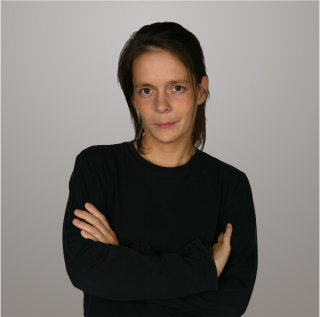In the story written in verse by Hungarian poet János Arany entitled Rose and Violet there is a scene when the heroine (Violet) asks some Gypsy children for a favour and promises a castle in the air in return. The children happily take possession of their easilyacquired manor but awake at dawn to find themselves lying shivering under the open air because their castle made of clouds has dissolved with the morning dew. “Rose took the beautiful Violet home/And the three little Gypsies were left in the palace:/Here they reposed but caught terrible colds,/because the poor little urchins had been sleeping in field.” In the interest of an optimistic ending the story can be blended with another well-known tale: despite receiving an elusive present the children became wiser.
Ray-painting, the venture of Dorka Berkes, also resembles a kind of “Spanish castle”: what we take away is the one-off quality of the experience. The genre, i.e. this incorporeal form which is the particular trait of ray-painting, could instantly be assigned to the “light-weight” category if it weren’t for the complex and minutely-designed machinery in the background. The enterprise, starting off as a casual undertaking, has in the last ten years grown into an almost routine-like artistic practice and with the symbolic illumination of the Brandenburg Gates of Berlin, introducing a Hungarian cultural year, appears to have virtually become established.
Ms Berkes seeks significant urban establishments as the medium of the projections: bridges, factory buildings and grandiose representative institutes serve as surfaces but vacant lots can also be “furnished” with the help of ray-painting. Neither the method nor the tradition are recent inventions; 19th century technical innovations and means of manipulating what we see all point to the refinement of (creative) vision. The ideology-creating experimental mood of classic avant-garde that found – a possibly rather utopian – satisfaction outside enclosed spaces should also be mentioned here. By incorporating new mediums and assuming both artistic and political positions avant-garde artists wished to build a new community for art and within this train of thought assigned visual communications a role of honour.
Dorka Berkes – void of ideological considerations – also believes that dealing with visual art is not a segregated artistic form. A possible answer to this could lie in her origins in the alternative party culture of the 90s – her other form of existence is DJ Dork.
Dorka Berkes started off by projecting sets for the Hungarian pop band Korai Öröm – initially within an enclosed space. The breakthrough was brought on with the illuminating open-air parties on Frank Hill (Budapest) and from 1996 she began presenting locationspecific space-painting in several European cities as well.
Berkes works with visual art as she does with sound materials. While bakelite records are the means of mixing, in the case of projection it is glass plate. This carefully-chosen medium bears the tale of how handicraft devices can bestow “complete” multimedia experiences on an increasing number of people. The genre is openly light, one-off and ephemeral, thus leaving behind no sense of nostalgia. Berkes assumes a humble approach towards the settings, meaning that the visual themes evolve within the framework of both the occasion and the location. She keeps deliberately to static images that are projected onto the surface from several sources at once. It is on the glass plate that Berkes elaborates her colourful parades, composed equally short and far ranging, in which we often recognise the great topics of history of art. She uses a variety of visual elements (ornamentations, symbolic images, brushwork extracts or simply large untreated surfaces) like a vast inventory – arbitrarily and with great practice. Several perspectives of time and space appear in her work and through the continuous varying of the points of view Berkes presents the spectator with the illusion of movement. This sense of illusion, however, is no trick or delusion, but instead a constant maintaining of a position of inquiry, furnished also with playful entertainment.
The Czech Zdenek Pešánek, the pioneer of photo kinetics, who affected by Constructivism and Futurism started experimenting with light, could be considered as Dorka Berkes’ model. Besides his immaterial, photo kinetic sculptures he conducted tests with fireworks, illuminated fountains and the lighting-up of buildings. It was Pešánek’s wide-ranging field of interests that led him to the construction of the colour organ, assembled at the end of the 1920s. With the help of photo kinetics he introduced a radical turn in the already dynamic 20s, not only undermining with the applying of new technologies the concept of plastic art but also intensively questioning the social function of art.
Dorka Berkes is one of the questioning types of artists blessed with great social sensitivity. Her intention is to expand into unregulated outlines the oblivious co-existence – still present in party cultures and alternative environments – in the spirit of a kind of involuntary “pleasantness” through music and visuals.

